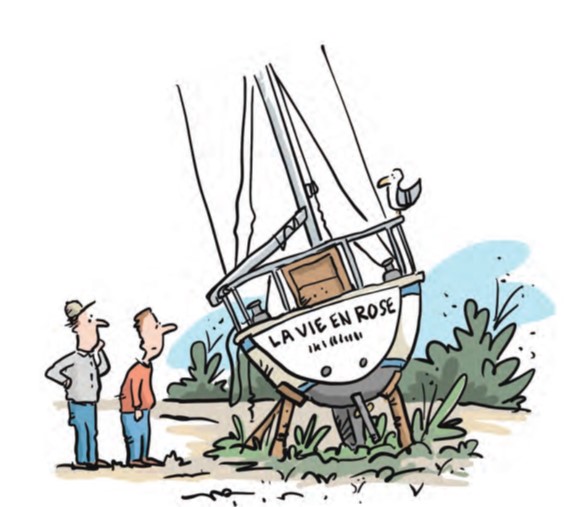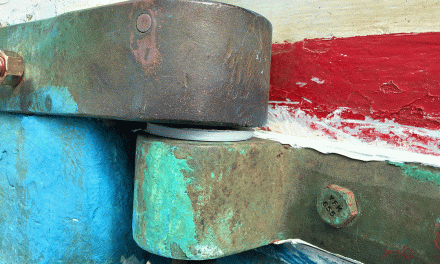A sailboat’s precarious final voyage takes teamwork, tools, and a 10-foot tide.
Issue 141: Nov/Dec 2021
Stretched out on my side amid tangled clumps of bittersweet and knotweed, my head resting on a rusty axle, my boots curled up against a tire, I tug on an exposed timber half-buried in the sand—a piece of rotted cradle barely holding up an abandoned sailboat. The timber comes loose, and I carry it to the beach and throw it into the bed of my truck. Holding a thumb in the air like a landscape artist, I size up the stern of La Vie en Rose. After four hours of adjusting the jack stands supporting the hull, it is, perhaps, coming closer to vertical.
La Vie en Rose, a 26-foot boat we’re pretty sure is an Ericson of the late 1980s, lies on the edge of my beach on Peaks Island, off Portland, Maine, atop shifting sand. There is no boat lift or crane to transfer her to the water; no tractor to push her seaward. She lists because after seven years above the high-tide line, her handcrafted wooden cradle has fractured, and the highest tides are licking at her keel. She is an accident in waiting, a fiberglass widow-maker.
My friend, John Carroll, has offered to help me deal with the problem. Earlier this morning, we gingerly positioned three jack stands on each side of the boat. This is not the first boat he’s moved. He’s placed wooden platforms under the stands for stability and linked each pair of stands with heavy chain so they don’t “kick out.”

Illustrations by Tom Payne
“Kick out?” I ask.
“Suddenly fail. No longer support the boat. That would be bad,” John says.
As we tighten the jack stands (which ranges from good solid work to backbreaking labor), I am hyperaware that I may need to scramble if there is a sudden crack or rumble. With a keel of at least 2,000 pounds lead ballast, we believe La Vie en Rose weighs in at about 5,000 pounds—not including all the gear and rainwater we know is inside her. Here’s what Practical Sailor has to say about jack stands: “After a marine lift plucks the boat from the water, your sole involvement is reading a warning in the lease agreement that you will not touch the stands and that you will not attach anything to them.”
That advice, of course, applies to a boatyard, which clearly is not the beach in front of my house. When my wife, Sandi, and I purchased our home on Peaks Island more than 35 years ago, we knew that the flat, hard-packed beach was traditionally used to launch, repair, and store boats and floats. I enjoy the sight of a working beach; it’s a bridge to the past. Despite the absence of a dock or wharf, it’s not unusual to see extension cords running from our porch window down to and over the gunnel of a boat needing repairs. At the end of the inshore lobster season in late October, lobster boats drop off dozens of traps at high tide and load them into trucks at low tide to transport them to island yards. Rowboats, dinghies, and sleek ocean kayaks nestle in the bushes.
The arrangement works well. I have hoped to achieve a balance with traditional uses and good environmental practices and avoid the restrictions of “I’ve got mine” elitism. And for the most part, this has worked; there has been remarkably little litter on the beach, and it’s easy to collect the
occasional beer can tossed up in the sumac. Sunbathers, fishermen, and recreational clammers co-exist in the intertidal zone.
Of course, there have been exceptions, such as the 42-foot wooden fishing boat that a dreamer dragged up on the beach intending to transform into a houseboat. Quickly overwhelmed by the scope of the project, the owner abandoned it; eventually, at a family reunion, my brother, Steve, took a chainsaw to the stern while the rest of us fed rotted oak into a bonfire and salvaged the intact cedar planks for a walkway.
And, there’s La Vie en Rose. The longtime owner is a Peaks Island local. Each spring, at low tide he drove his truck onto the beach, pulled the sturdy homemade cradle to the water’s edge, and launched the boat, courtesy of Casco Bay’s 10-foot tides.
Each fall he reversed the process. And the boat was well used; he more or less lived aboard in the summer, sailing to Casco Bay’s outer reaches and sleeping aboard for long weekends. Then, seven years ago, the sailboat sat through the summer. One year became two. Bittersweet curled up over the hull and entangled the boom and halyards. The supporting beams of the cradle splintered. I called the owner. Don’t worry, he assured me, he would either rebuild the cradle, or perhaps— and he hated to think about this—sell La Vie en Rose.
But any hopes of the owner repairing the cradle evaporated when he was in a motorcycle accident and a few weeks later suddenly went blind. It was a devastating, life-changing tragedy.
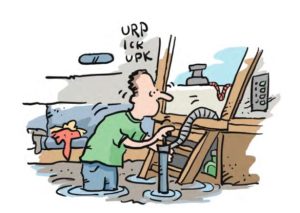
When the boat began to list, I worried that it might suddenly fall over and injure or kill someone. Complicating things, the owner claimed that the boat was not on my property. Phone calls with a maritime lawyer, our island police, the Coast Guard, and the harbor master achieved no resolution. I built a fence around the sailboat and hung up a For Sale sign with the owner’s phone number. There were no takers.
When John offered to help me jack up the boat, I asked him why. “Two simple reasons, you are a friend in need, and it has to get done.” The abandoned boat wasn’t just my problem, he said, it was an accident waiting to happen for the entire island. Who knew when a curious teenager might be injured climbing into it? What fifth grader pays attention to a fence or sign?
John is certain that we can straighten and lift La Vie en Rose, block the keel, and once we can safely board, pump out several thousand pounds of water from the interior.
“From there, we can figure out the next step,” he says. “This boat belongs in the water.”
I know nothing about moving a boat to the water. In truth, I know almost nothing about sailboats. I am tasked with doing exactly what John tells me to do. When I am not tightening jack stands, I am clearing out debris from beneath the sailboat, although debris doesn’t properly capture the Bronze Age, archaeological nature of the remains of the cradle and trailer—half-buried, decayed, 6-x-6 spruce beams, rusted truck-sized wheels connected to a bent axle, all held together by reinforced iron plates.
The incoming tide flows across the mudflats—perhaps three hours from lapping against the tires of my truck. Oblivious to us, several great blue herons work the shallows for crabs and small fish while a flock of eider dive for mussels just offshore.
After lunch, we redouble our efforts until the boat comes to vertical. I gingerly climb into the cockpit and jimmy open the companionway, where a beautiful edging of pale green lichen lines the wood trim. I step below and retch at the complex odors of mold, oil, gasoline, standing water, rust, and decayed wood. I pull out my phone and shine a light in the tomb. The engine is half submerged. A yellow rain slicker, piles of discarded clothes, mildewed magazines, rope, and rusted tools litter the bunks. I place one end of a hose in the water and work a hand pump until a torrent flushes onto the beach.
“Chuck,” John says as we watched the water cascade down the sand, “as long as La Vie en Rose is on your beach, it will never be totally safe. The highest tides will eventually undermine the stands and the boat will fall. It’s another sad example of the old adage, ‘no good deed goes unpunished.’ ” He tells me to call Captain Jim’s Marine Salvage and Nautical Antiquities.
“Once we launch La Vie en Rose and she’s on a mooring, he can take her for salvage.” John walks around the hull tapping it with a hammer. “I think she’s basically seaworthy. It’s a shame she can’t find a new home.”
I move the truck. We gather our tools. The tide meets the stern of the boat.
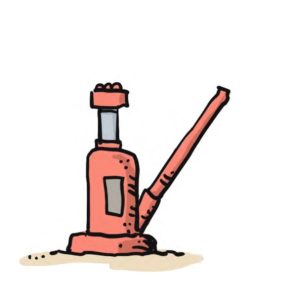
To actually launch the boat, we need to build a temporary cradle that can move her down the beach to meet the tide. That doesn’t happen for another couple of months, when John and I meet another friend, Chris Roberts, on the beach with his truck and flatbed trailer. It is loaded with, among other things, 2 x 4s, a cordless circular saw, a Sawzall, several bottle jacks, a grinder with a cut-off blade, drill, shovels, crowbars, steel pipes for rollers, chains for pulling, boxes of miscellaneous nails, screws, and lag bolts, wrenches, and a stack of wooden blocking. John’s truck is also burdened with key components, namely two 6-x-6, 11-foot beams and close to a dozen 2-inch steel rollers.
I feel, well, strangely competent with my Thor-sized mallet and crowbar. A few minutes later, Chris parks his Kubota tractor next to the truck. He sums up our chances: “With the right tools and a sharp blade, you can move anything.”
The six jack stands safely support the boat, but we need to build the temporary cradle inside the stands before we can slide La Vie en Rose to the water. The two long beams John brought will be the foundation of our sledge. We’ll attach a crib to the top of the beams before backing off the jack stands. Then, we’ll raise the cradle and boat with bottle jacks to sandwich metal rollers between the underside of the beams and a series of long planks pointing towards the water. If all works as planned, the sailboat will roll down the plank road and the next tide will float it off the cradle.
John says, “I’ve moved a lot of boats around. The bigger the move, the smaller each step. We have a good team process: Stop, think five steps ahead, and work methodically without haste.”
I think: I have never moved a boat. Stay alert. Don’t lose a limb.
After clearing out the remains of the old cradle, Chris places a bottle jack on a platform of blocks in the midline of the hull. It is an unimpressive piece of equipment, about the size of a coffeepot, but capable of lifting up the corner of a small house. Chris inserts a metal rod into the bottle jack and rapidly moves it up and down, elevating the boat a fraction of an inch each time. We loosen the jack stands slightly so the boat can rise, adjusting the connecting chains each time and listening for creaks or groans indicative of structural failure.
By midafternoon, we lay the two parallel beams inside the jacks. After Chris drills pilot holes, I use a ratchet wrench to drive lag bolts into the beams and build out the crib. This takes several hours. Then it’s back to the bottle jacks so that we can place boards and metal rollers under the beams in preparation for the move. We’re getting tired. Between the three of us, we are roughly 200 years old.
The rollers and boards slide under the beam with considerable difficulty. I get to use my mallet, the perfect tool to pound the leading edge of the board in place. We remove the temporary jacks. The sailboat still stands.
The tide is at ebb. By eleven tonight, it will be high. If we can move the sailboat 50 feet down the beach, the flood tide may, possibly, float it off the cradle. Chris hops on his tractor and positions the bucket against the bow, and his wheels spin for traction. John and I crouch at the downhill side of the beams holding blocks to use as brakes if the boat moves too fast. The boat slides shoreward. Six inches. Two feet. Ten feet. I let out a whoop!
Chris backs the tractor away, and John and I place new rollers beneath the leading edge of the beam. For another 10 feet, all is well, then the beam inexorably slides partway off the rollers.
Chris changes the angle of his bucket pushing the bow. We add more rollers and adjust the planks. La Vie en Rose moves seaward. Then one beam slips off the rollers and is no longer on a plank. The boat lists ever so slightly. I hold my breath.
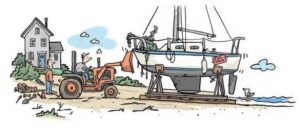
We’re not nearly far enough for a successful launch. Playing his trump card, Chris calls his friend, Travers, who owns an ancient Holmes wrecker. A half-hour later, Travers arrives and parks the truck a few feet from the incoming tide. He plays out cable through an overhead crane and attaches the free end to the sledge. After setting the stabilizers, he flips a switch. The cable tightens; we involuntarily step back. Impossibly, the sailboat moves another few yards. It’s probably not far enough.
Travers moves his truck closer to the sailboat. He resets the stabilizers and repeats the process. When the sledge refuses to budge, he guns the motor, and abruptly the front end of the truck pops a wheelie. There is a collective gasp before Travers manages to release the cable pressure and the front tires settle onto the sand. He’s game for one more try. When the cable suddenly breaks, he calls it a day.
Chris and John believe La Vie en Rose will launch tonight at high tide. I think, no way.
Shortly after midnight, John and I meet at Chris’ skiff and motor towards the beach in a wet, cool fog so impenetrable that cottage lights on the shore are like distant fireflies. John pans a flashlight over the bow, alert for mooring balls and lobster buoys. The gray curtain parts. John gives a shout.
Up ahead, off to port, a sailboat is bobbing in the water. It is La Vie en Rose. On the darkened beach, a figure waves. It’s Craig, a neighbor who, I later learn, was concerned about the cradle and wood drifting into the shipping channel, so he swam out and retrieved them when he saw La Vie en Rose float free. We tow the sailboat to a mooring and go to bed.
The next morning, I receive a text from Chris: Sailboat taking on water. Not sinking. By the time John and I meet Chris at the dock and row out to the boat, he’s already fashioned a temporary pump and removes a whale gusher of raunchy water from the bilge. Chris determines that the through-hull fittings for the sink and head are open and taking on water. He closes them, and the leaks stop.
In short order, I arrange for Captain Jim to pick up the boat from a marina in Portland. I call the owner of La Vie en Rose and tell him I want to officially assume ownership so I can hand it off to Captain Jim. He sells her to me for a dollar.
On the day we bundle into Chris’ skiff to tow La Vie en Rose to Portland, John is having second thoughts. He is a romantic at heart.
“Chuck, it’s a shame for her to go to salvage. We could form a syndicate with multiple owners, time share. What do you think?”
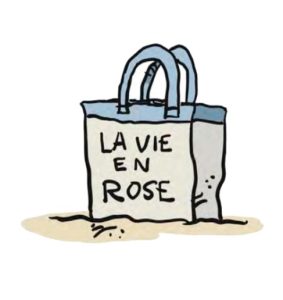
I am vaguely aware that John recently bought the Grammie Annie, a lobster boat with similarities to a neglected puppy needing a new home. On the other hand, until today, I have never owned a sailboat. What could possibly go wrong?
Chris ignores our chatter, wraps the towline to the bow cleat of La Vie en Rose, and suggests that John get onboard to steer. Thinking back, I believe this was to separate us to save us from ourselves.
Underway, La Vie en Rose rides our wake, pointing towards Portland, her final resting place. A sprig of bittersweet curls around her bow, pulled from the underbrush when the tractor pushed her seaward for one last journey. I look over to my beach. It looks sadly antiseptic. Barren. Unused.
Captain Jim will get a good price for La Vie en Rose’s mast and make a profit on her stainless steel railings, ladder, halyards, and cleats. There is a market for the keel’s lead. Even the hull will be sold and ground up to be mixed with gravel for resurfacing mainland roads.
When we reach the marina, a launch rafts up to the sailboat and John transfers aboard our skiff. We watch as La Vie en Rose is slow-walked towards a boat lift, much like a prisoner is escorted to the gallows after a last meal. She’s floating out of this world the same way she came in.
I’ve already dropped off her sails at Sea Bags on Custom House Wharf where they will be cleaned and transformed “into nautically inspired totes and accessories that bring our customers great happiness.” In exchange for the sails, I’ll receive two free tote bags, and possibly great happiness. And perhaps I’ll stop by Captain Jim’s later. Maybe there’s another trinket or two to remember her by.
For more than three decades, Dr. Chuck Radis and his family have lived on Peaks Island, commuting to the mainland year-round on his boat, Dasakamo. Early in his medical career, he provided primary care to four islands in Casco Bay, traveling by boat and logging more than 100 yearly house calls. He has been named the Louis Hanson Maine Physician of the Year, and Teacher of the Year at the University of New England, College of Osteopathic Medicine, where he is a clinical professor of medicine. His book Go by Boat: Stories of a Maine Doctor was published in April.
Thank you to Sailrite Enterprises, Inc., for providing free access to back issues of Good Old Boat through intellectual property rights. Sailrite.com

